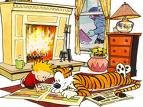
This is a wonderful true story about how a young boy learns some of life's best lessons while working a small ranch with his father. I love simple heartfelt stories like this, and like the cover says it is a perfect book to read aloud. If you are like me and believe that you are what you read, then you will learn a lot from this book.
Amazon.com review:
Without the flamboyance or the caricature of other "life with Father" books this tells, simply, directly of the Moody family and their life in Colorado. Father's health necessitated a move and all seven of the Moodys moved to a godforsaken little ranch. There Little Britches learned how to face a situation, through emphatic lessons and Father's kindly but firm insistence on cause and effect. This is the story of hard luck, stubborn pride, and altruistic community endeavor, for Father is the one who evolves a solution for the water problem, and of the implanting of an honest, moral philosophy. It is the story too of Little Britches' first earnings, of his interrupted schooling, of his Indian friend, Two Dog, who added to the excitement of the new life, of the many accidents culminating in nine broken toes, of his burning desire to be accepted in a man's world. And how he went from cow poke to bronc buster, cowboy on the Y B mountain spread, and rodeo rider, until Father's death made him head of the family and his courageous Mother's indispensable right-hand man. Real stuff here with none of the artificiality of the more eccentric domestic chronicles. (Kirkus Reviews)
Other books in the series include: Man of the Family, The Home Ranch, Mary Emma and Company, The Fields of Home, Shaking the Nickel Bush, The Dry Divide, and Horse of a different Color.






